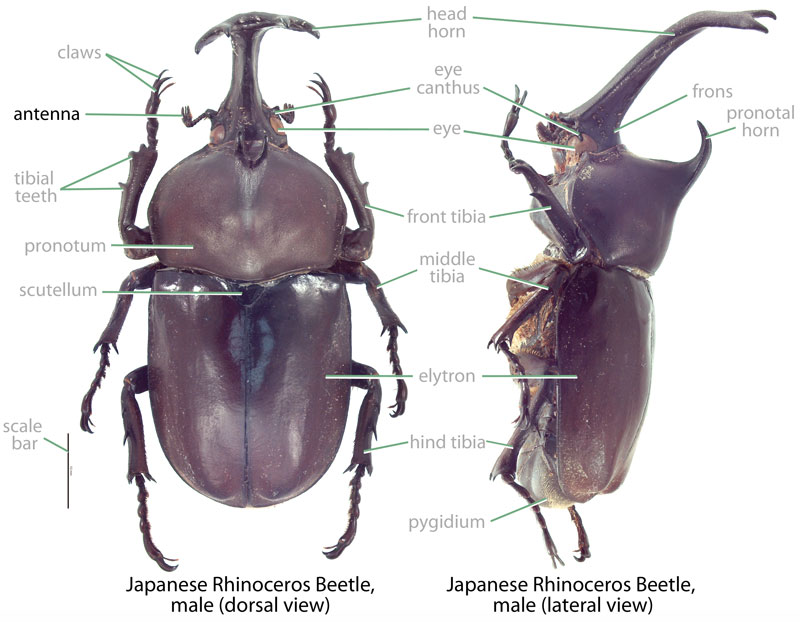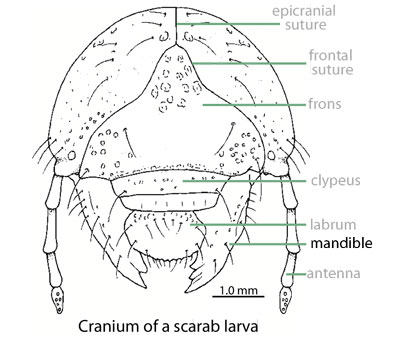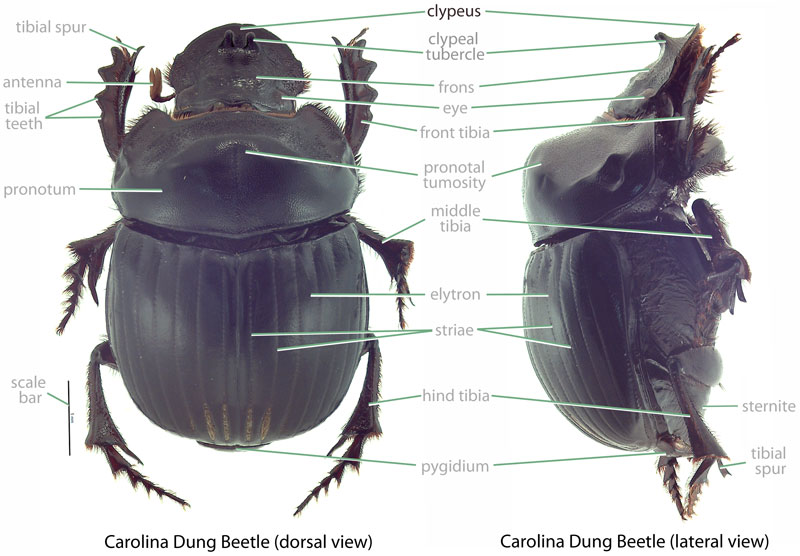Potential Invader
none known
Family: Hybosoridae Subfamily: Hybosorinae Genus: Hybosorus Species: Hybosorus roei Westwood, 1845
none available
Total body length 5.0–7.0 mm (0.19–0.28 in). Color above shiny black. Body vaguely egg-shaped in dorsaldorsal:
of or relating to the upper surface; opposite of ventral
view; dorsaldorsal:
of or relating to the upper surface; opposite of ventral
surface convex. ElytraElytra:
the hardened and chitinous wing-cover of a beetle that protect and overlie the flight wing
with numerous distinct, punctatepunctate:
a surface texture characterized by numerous puncture-like marks or impressions, often described in terms of puncture size, shape, and density
striae. AntennaeAntennae:
paired sensory organ on head, formed from numerous segments
 with 3-segmented club; first segment of club enlarged, hollowed to hold second segment. MandiblesMandibles:
with 3-segmented club; first segment of club enlarged, hollowed to hold second segment. MandiblesMandibles:
The crushing or chewing portion of an insects mouthparts
 prominent, visible in dorsaldorsal:
prominent, visible in dorsaldorsal:
of or relating to the upper surface; opposite of ventral
view. Clypeusclypeus:
part of the head anterior to the frons; the most anterior portion in dorsal view
 narrow, not widely broadened.
narrow, not widely broadened.
Undescribed. For Hybosorus spp. (Grebennikov et al., 2004Grebennikov et al., 2004:
Grebennikov V, Ballerio A, Ocampo F, Scholtz C. 2004. Larvae of Ceratocanthidae and Hybosoridae (Coleoptera: Scarabaeoidea): study of morphology, phylogenetic analysis and evidence of paraphyly of Hybosoridae. Systematic Entomology 29: 524–543. full text (accessed 2015)): Grub C-shaped, cylindrical, not hump-backed, whitish. Maxillamaxilla:
set of paired mouthparts located posterior to the mandibles
with galeagalea:
outer branch or lobe of the maxilla
 and lacinialacinia:
and lacinialacinia:
inner portion of the maxilla distinctly separated. Frontoclypeal suturefrontoclypeal suture:
distinctly separated. Frontoclypeal suturefrontoclypeal suture:
transverse suture between the clypeus and frons
distinct. Labrumlabrum:
upper lip that covers the mandibles and is located ventrally relative to the clypeus
 at apexapex:
at apexapex:
point or edge furthest from the body
with 3 truncatetruncate:
appearing cut-off or suddenly shortened
lobes. Antennomeres 2 and 3 separate. Combined apical antennomereantennomere:
an individual segment of the antennae
with markedly narrowed base and widened apexapex:
point or edge furthest from the body
; two combined apical antennomeres with 10 long setae; tormaetormae:
in scarab larvae, sclerotized structures on the ends of the clypeolateral suture extending towards the mesal line
united. Short and flattened setaesetae:
small, hair-like structure
of palidiapalidia:
paired group(s) of recumbent (reclining) spines, usually occurring in rows; part of the raster
pointed towards apexapex:
point or edge furthest from the body
.
Old World. The native range of this species includes vast regions of the Old World, ranging from temperate areas in Europe and China to tropical and subtropical regions of the Middle East, India, Vietnam, and all of Africa except the Sahara (Ocampo, 2002Ocampo, 2002:
Ocampo F. 2002. Hybosorids of the United States and expanding distribution of the introduced species Hybosorus illigeri (Coleoptera: Scarabaeoidea: Hybosoridae). Annals of the Entmological Society of America 95: 316-322. full text (accessed 2015)).
Possibly turf grasses. LarvaeLarvae:
the immature form of an insect; in scarabs, also called grub or white grub; preceded by the egg stage, followed by the pupal stage
 of this species are reportedly pests of turf in the mainland U.S. (Barden, 2011Barden, 2011:
of this species are reportedly pests of turf in the mainland U.S. (Barden, 2011Barden, 2011:
Barden S. 2011. Red imported fire ant influences on white grub populations and soil foraging characteristics in managed turf grass. PhD dissertation, Auburn University, Alabama. full text (accessed 2015)). Adults are not known to feed on plants (Ocampo, 2002Ocampo, 2002:
Ocampo F. 2002. Hybosorids of the United States and expanding distribution of the introduced species Hybosorus illigeri (Coleoptera: Scarabaeoidea: Hybosoridae). Annals of the Entmological Society of America 95: 316-322. full text (accessed 2015)).
(Ocampo, 2002Ocampo, 2002:
Ocampo F. 2002. Hybosorids of the United States and expanding distribution of the introduced species Hybosorus illigeri (Coleoptera: Scarabaeoidea: Hybosoridae). Annals of the Entmological Society of America 95: 316-322. full text (accessed 2015)): Adults of this species appear to be carnivorous, feeding on both carrion and other invertebrates. Adults are attracted to dung where they feed on small dung beetles and other coprophagous insects. In the U.S., adults have been collected from February to October and are most active in the months of May and June. Eggs are laid in the soil. LarvaeLarvae:
the immature form of an insect; in scarabs, also called grub or white grub; preceded by the egg stage, followed by the pupal stage
 may feed upon plant roots and/or detritusdetritus:
may feed upon plant roots and/or detritusdetritus:
organic debris; particularly plant debris
, similar to other hybosorid species.
Moderate. Although it is not clear that larvaelarvae:
the immature form of an insect; in scarabs, also called grub or white grub; preceded by the egg stage, followed by the pupal stage
 feed on grass roots, this species is reported as a destructive turf pest (Barden, 2011Barden, 2011:
feed on grass roots, this species is reported as a destructive turf pest (Barden, 2011Barden, 2011:
Barden S. 2011. Red imported fire ant influences on white grub populations and soil foraging characteristics in managed turf grass. PhD dissertation, Auburn University, Alabama. full text (accessed 2015)). Because adults feed on dung beetles, this species could be problematic for ranching. Hybosorus roei also has a well-recorded history of rapid invasion into new areas (Ocampo, 2002Ocampo, 2002:
Ocampo F. 2002. Hybosorids of the United States and expanding distribution of the introduced species Hybosorus illigeri (Coleoptera: Scarabaeoidea: Hybosoridae). Annals of the Entmological Society of America 95: 316-322. full text (accessed 2015)) where it can reach high population densities (Buss, 2006Buss, 2006:
Buss E. 2006. Flight activity and relative abundance of phytophagous scarabs (Coleoptera: Scarabaeoidea) from two locations in Florida. Florida Entomologist 89:32-40. full text (accessed 2015)). This species arrived to the mainland U.S. (probably South Carolina) sometime in the 1840's, possibly on an incoming slave ship from Africa (Woodruff, 1973Woodruff, 1973:
Woodruff R. 1973. The scarab beetles of Florida (Coleoptera: Scarabaeidae) part I. The Laparosticti (Subfamilies: Scarabaeinae, Aphodiinae, Hybosorinae, Ochodaeinae, Geotrupinae, Acanthocerinae). Arthropods of Florida and Neighboring Land Areas 8: 1-220.). Though its range expanded slowly at first, the second half of the 20th century saw a rapid expansion of the species' range in the Americas. Hybosorus roei is now known from much of the southern half of the U.S., Mexico, Caribbean Islands, Central America, and Colombia (Ocampo, 2002Ocampo, 2002:
Ocampo F. 2002. Hybosorids of the United States and expanding distribution of the introduced species Hybosorus illigeri (Coleoptera: Scarabaeoidea: Hybosoridae). Annals of the Entmological Society of America 95: 316-322. full text (accessed 2015)).
Not established or recorded. There are no records of this species from Hawaii, although it should be regarded as likely to arrive in the future.
Not established or recorded. There are no records of this species from Guam.
This species is strongly attracted to lights at night and is a capable flier (Ocampo, 2002Ocampo, 2002:
Ocampo F. 2002. Hybosorids of the United States and expanding distribution of the introduced species Hybosorus illigeri (Coleoptera: Scarabaeoidea: Hybosoridae). Annals of the Entmological Society of America 95: 316-322. full text (accessed 2015)). Thus, it is likely that this beetle would be attracted to well-lit ports and airports. This would allow for hitchhiking on marine or air cargo. Further, it is possible that larvaelarvae:
the immature form of an insect; in scarabs, also called grub or white grub; preceded by the egg stage, followed by the pupal stage
 or eggs could be transported in shipments of commercial turf. It should be regarded as having a significant chance of arriving to Hawaii or Guam in the future.
or eggs could be transported in shipments of commercial turf. It should be regarded as having a significant chance of arriving to Hawaii or Guam in the future.
While the egg-shaped body of this species is distinctive, it might be confused with similar-sized dung beetles. It is separated from the dung beetles based upon the clypealclypeal:
of, or referring to, the clypeus
shape (Hybosorus roei with narrowed clypeusclypeus:
part of the head anterior to the frons; the most anterior portion in dorsal view
 versus comparably broad clypeusclypeus:
versus comparably broad clypeusclypeus:
part of the head anterior to the frons; the most anterior portion in dorsal view
 in most dung beetles) and mandiblesmandibles:
in most dung beetles) and mandiblesmandibles:
The crushing or chewing portion of an insects mouthparts
 (Hybosorus roei with mandiblesmandibles:
(Hybosorus roei with mandiblesmandibles:
The crushing or chewing portion of an insects mouthparts
 visible when viewed dorsally versus mandiblesmandibles:
visible when viewed dorsally versus mandiblesmandibles:
The crushing or chewing portion of an insects mouthparts
 never visible dorsally in dung beetles).
never visible dorsally in dung beetles).
Hybosorus carolinus LeConte, Hybosorus illigeri Reiche, Hybosorus nitidus Lansbergel, Hybosorus oblongus Dahlbom, Hybosorus pinguis Westwood, Hybosorus thoracicus Westwood
This species was long known as Hybosorus illigeri, and it remains widely known and reported under that name.
In Hawaii, this species represents a new invasiveinvasive:
a species that has recently arrived to a new location, usually via human activity, causing notable economic and/or ecological damage
species. Prevent the spread of this species by reporting your observation at our iNaturalist project.